I knew that I needed a really big coffee table and while they do exist on the market, the ones that I loved were in the thousands. Then I figured that if I were going to spend a chunk of change I’d rather work with a local maker on something unique and special. Plus I really wanted to create some joy and form relationships through the process (and learn a lot so I can share). So today I’ll walk you through the 2-month process that I enjoyed every second of. (Oh, and check out that sofa:))
Our Living Room (A Few Months Ago)
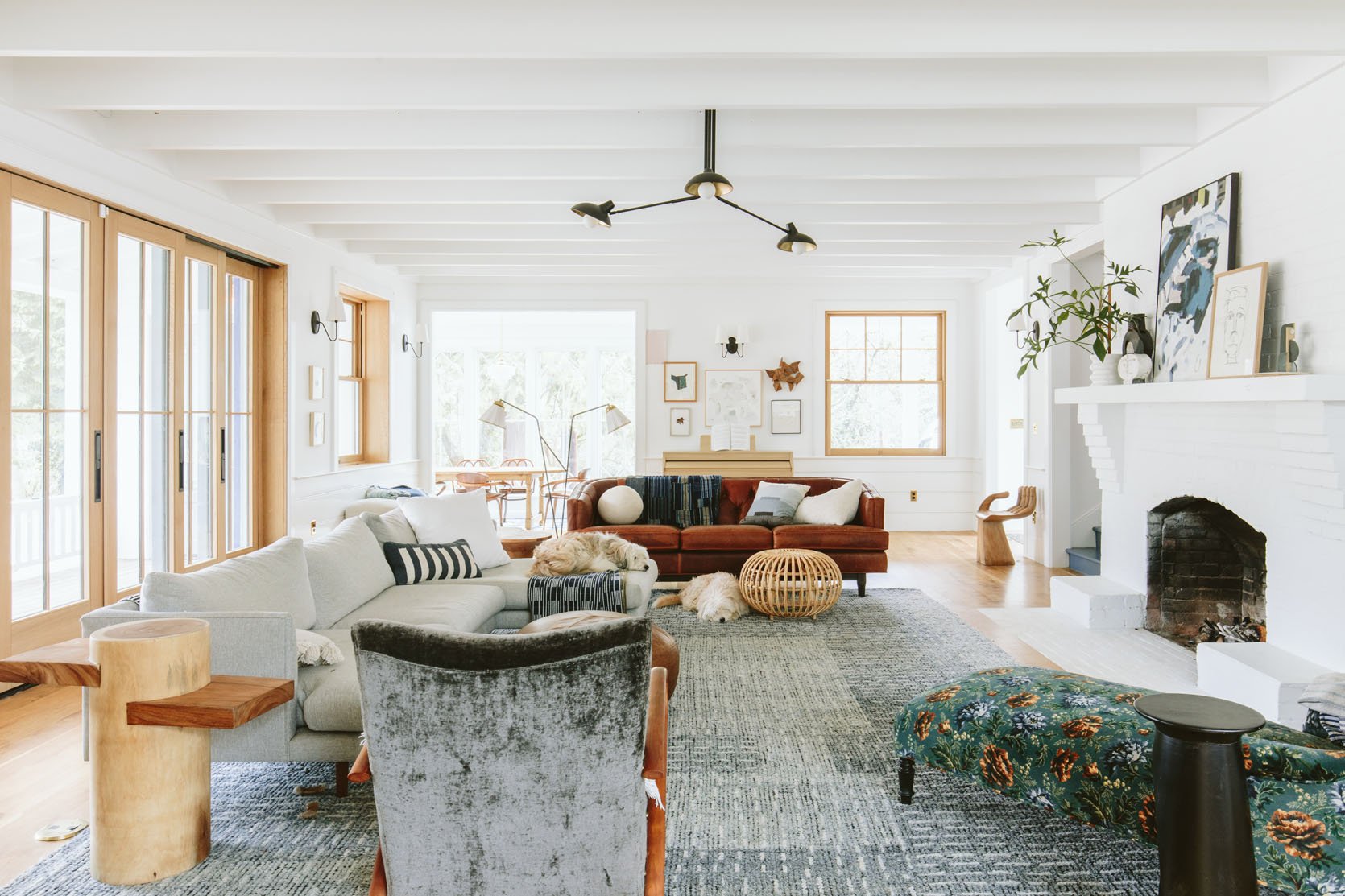
Swivel Chairs (from opening photo) | Rug | Sectional | Leather Pouf (similar) | Leather Sofa | Rattan Ottoman | Sconces | Chandelier | Black Side Table
In case you need a visual reference this is an older version of our living room, before we finalized placement and got some new pieces. But you get the idea – it’s big and it’s a pass-through space so organic shapes (or ovals) lend themselves to this much more. Now I could have gone a few different ways, but really wanted a huge dark live-edge table for the following reasons:
1. Because it would be very grounding – the centerpiece on a big dining table as it were.
2. It’s an organic shape that is neither round nor rectangular (so it’s a great contrast/addition to both of those typical furniture shapes).
3. Because it’s a literal tree root it can’t be mass manufactured the same way other materials can – this shape will never exist in another table and while I’m not obsessed with having something custom just for the sake of exclusivity, I also didn’t want to customize something that would then just get easily knocked off. Yes, live edge coffee tables have existed for decades and I’m not inventing the concept, but I like that the shape, species, and the age of the tree is really in charge of the design which inherently means that it’s non-duplicatable.
4. I’ve decided that I never get sick of high-quality wood, anything. Because of that fact, I feel ok investing further into it. Yes, there are great affordable versions of them on the market and I love those, too. But this shape just checks a ton of boxes for me.
5. It’s my woo-woo belief that everything has energy and living things specifically have a soul. It’s why I went with reclaimed wood in the mountain house, and Zena wood flooring for this house. I want to make sure (when possible) that the wood that I bring into our house had a happy life as a tree and that the people who work on it (same with tile, which is why I love Pratt + Larson and Rejuvenation lighting) have happy lives, too. This one was old (and happy?) and fell in the ’70s in southern Oregon (so I was told). I wasn’t really interested in getting one from a “dealer” although honestly most trees in Oregon are pretty darn happy and have had good lives so I wasn’t concerned about that.
So I texted Purl, a local maker/artist in town who I love, and flagged it for him. I said, if you find a huge ideally reclaimed slab of wood, let me know – I’d be interested in a coffee table. After meeting Purl at the flea market last year I just knew that I wanted to collaborate with him somehow because his energy is incredible, playful, wildly creative/artistic and he is so prolific (I think he’s going to be a real art force, y’all). I feel incredibly grateful that at this point in my career, I can hire local makers and artists to do their thing to create works of art in our home.
A Few Weeks Later He Texted Me Photos:
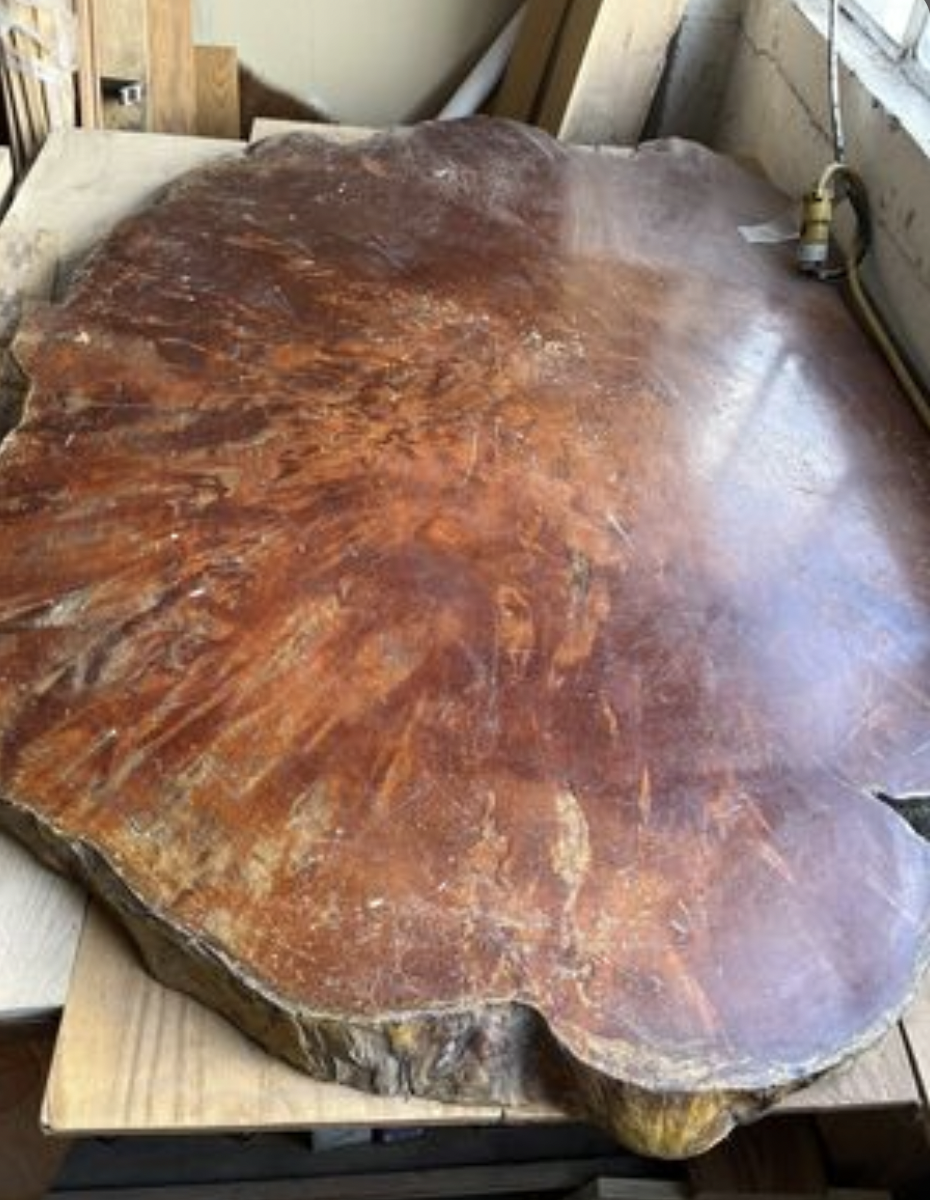
He said the size was 46″ x 62″, reclaimed redwood that was clearly refinished in the 70s with the finish not in the best shape. It’s huge so it was probably a really old (and happy) tree. Part of me wanted to look for bigger, but with the deadline coming up I knew that this was probably big enough. So I asked Purl if he could refinish it to be less shiny/beat up and then make the hard edge more organic. He said absolutely and a week later sent through these photos.
Stripping, Sanding, Planing, And Shaping
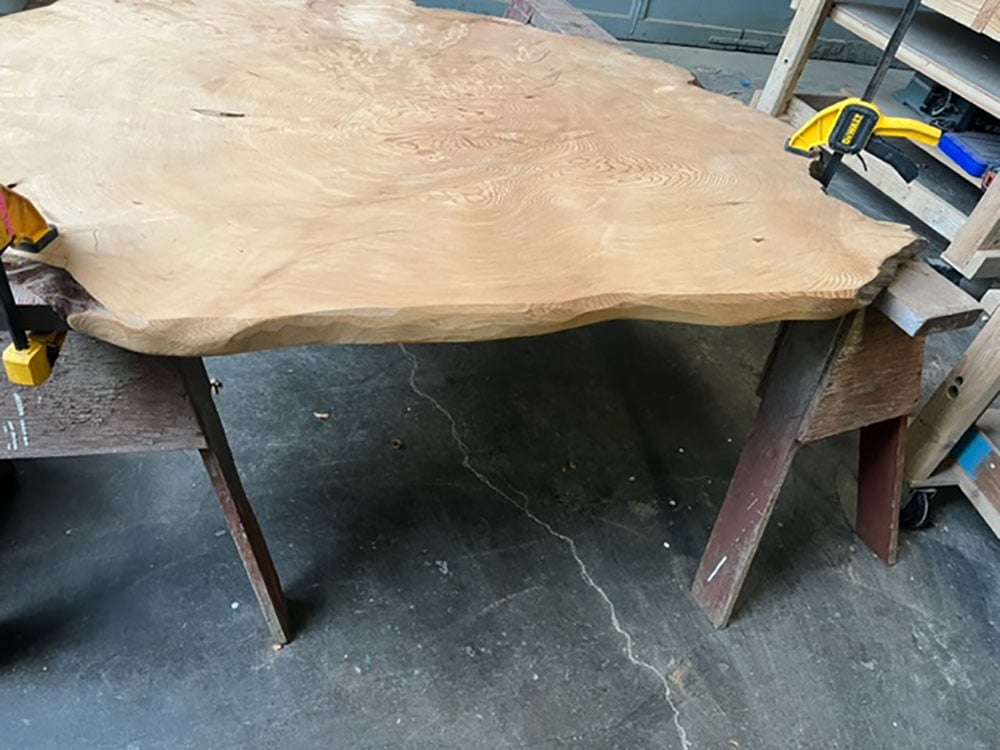
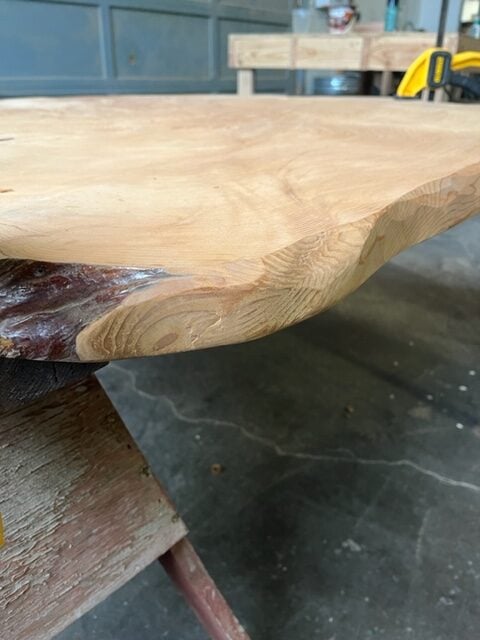
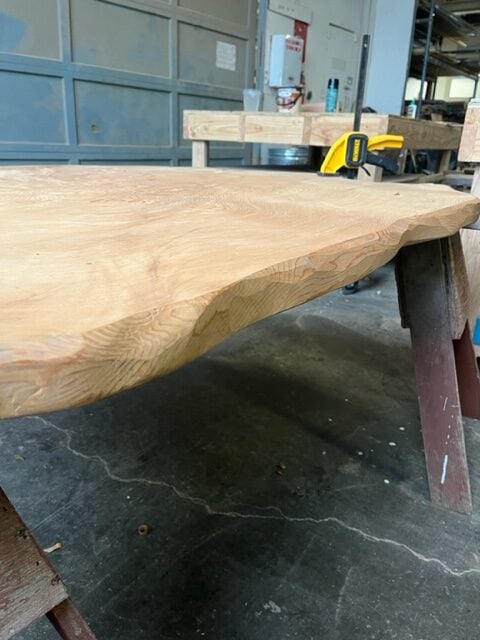
SO BEAUTIFUL. He sanded and planed the wood and then softened that hard edge so that the whole table had a more organic shape. Yes. Yes. Yes. I didn’t need to see it at this point because I knew I wanted dark, rich wood. I sent him some reference photos of the stain color I wanted and he went for it.
First Coat Of Stain
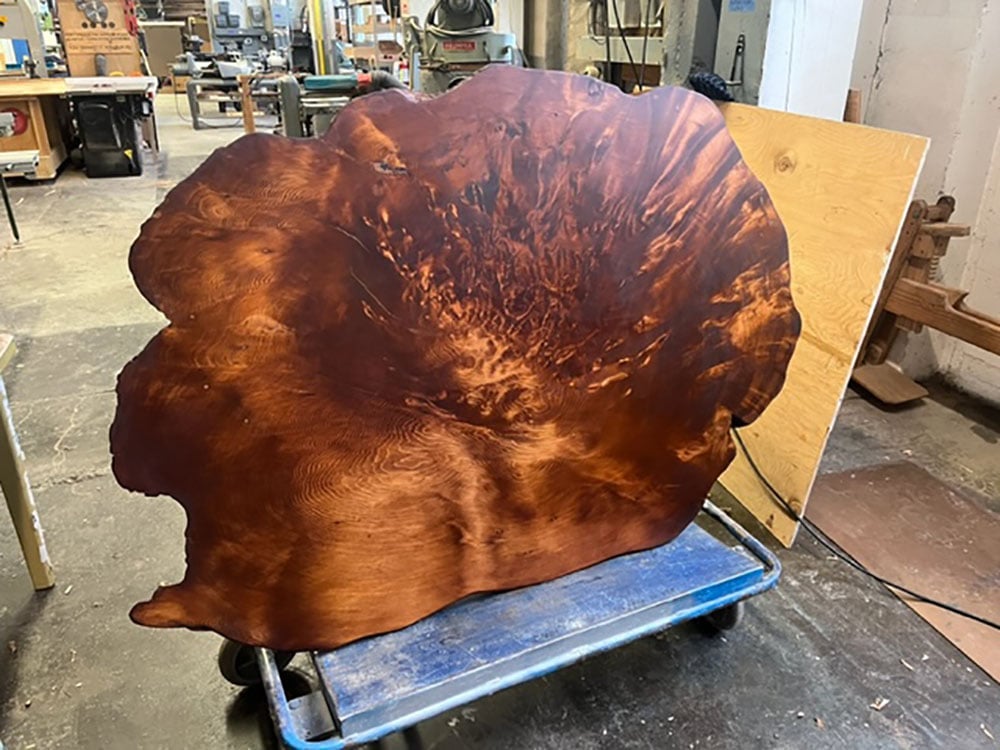
The first coat brought out all the movement in the grain and we loved it, but immediately said, “Go darker”! We were hoping (and fairly confident) that a few more coats would even it out and pull down the orange.
A Visit To The Studio
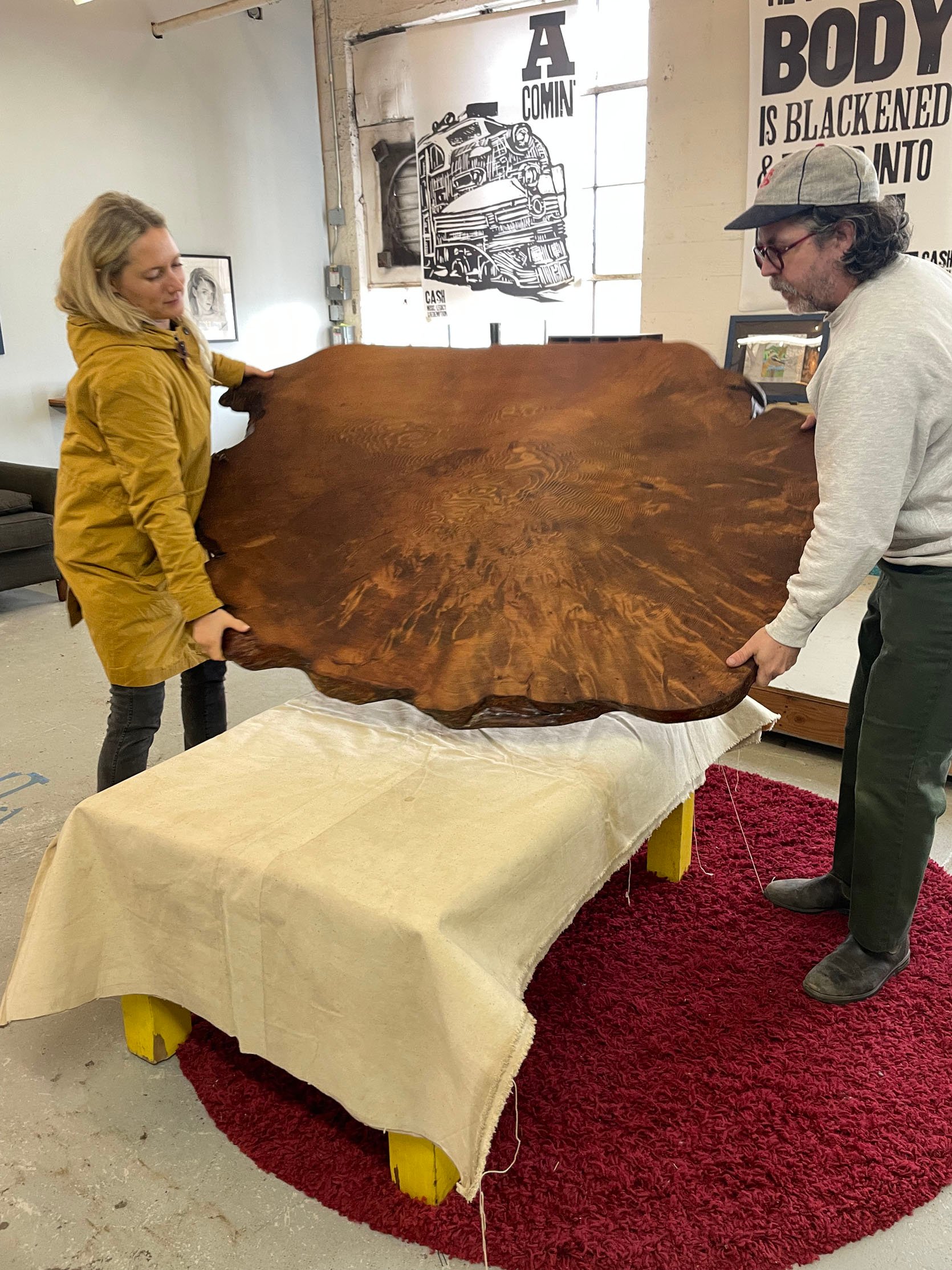
Purl and other artists work out of Past Lives Makerspace which was incredibly inspiring to tour. We went to see it in person and make sure that we agreed on which side was “up” and talked through base ideas. Purl suggested his friend, local Blacksmith and fellow studio mate, Billy to help us design it. At this point, I knew that I could take a simpler/less expensive route and just do a big chunky cross wooden base, but when Purl suggested doing some custom iron blacksmithing work I got really excited to learn what that meant.
I treated this like a proper commission (which I’ve never done before) where I gave my needs/wants and initial ideas, but I really wanted them to have creative freedom and not just dictate the design. So in addition to the refinishing, I hired Purl to oversee the art direction of the base and ensure that it came together on time.
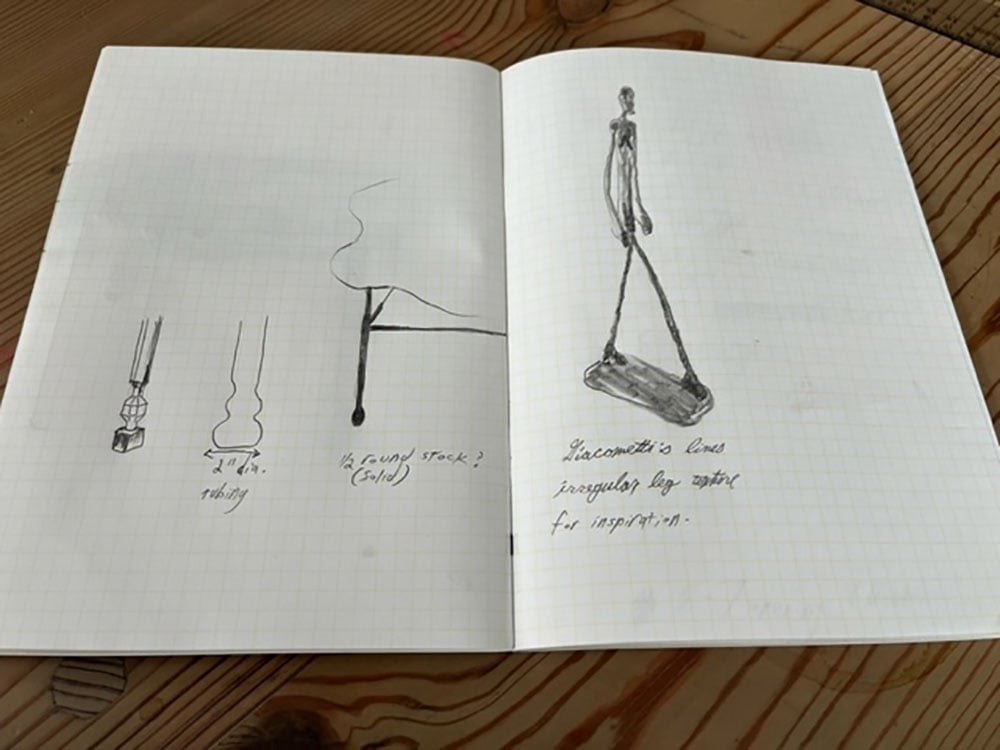
These were Purl’s initial design sketches for the legs. To the right, he’s pointing to sculptor, Alberto Giacometti for inspo. On the left were different leg iterations, the first one too structured, the third too simple, so we landed somewhere closer to the middle.
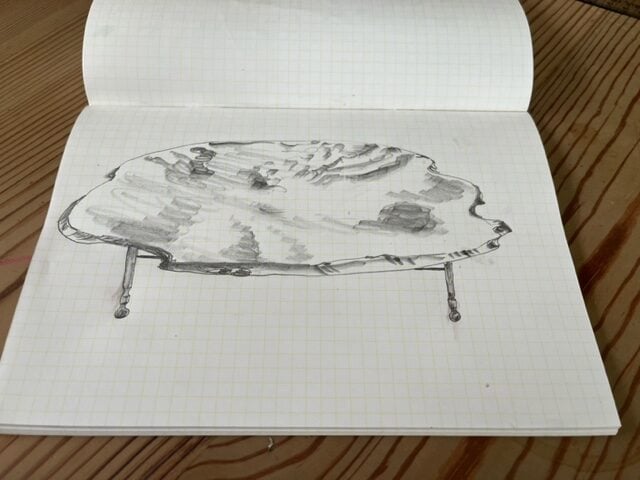
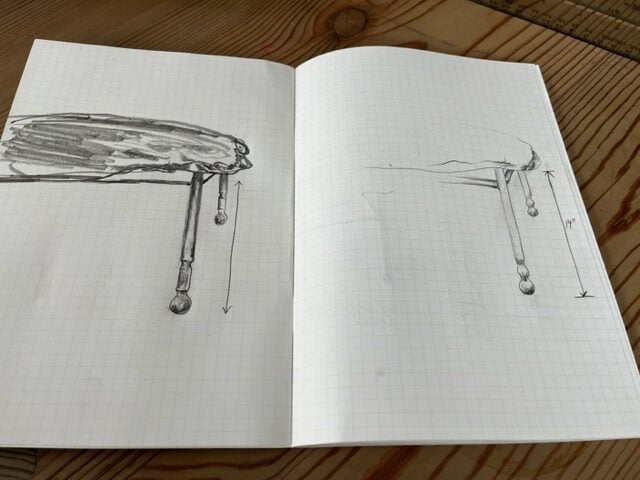
Here’s an awesome early sketch by Purl that ended up looking pretty close to the final product. We knew we wanted to keep the coffee table low to emphasize that “grounding” feeling. We landed on 13” legs to go with the 2” thick slab. 15” feels like just the right height for the space. As a tip – coffee tables can be much higher of course, but when they are huge they should be low (IMO).
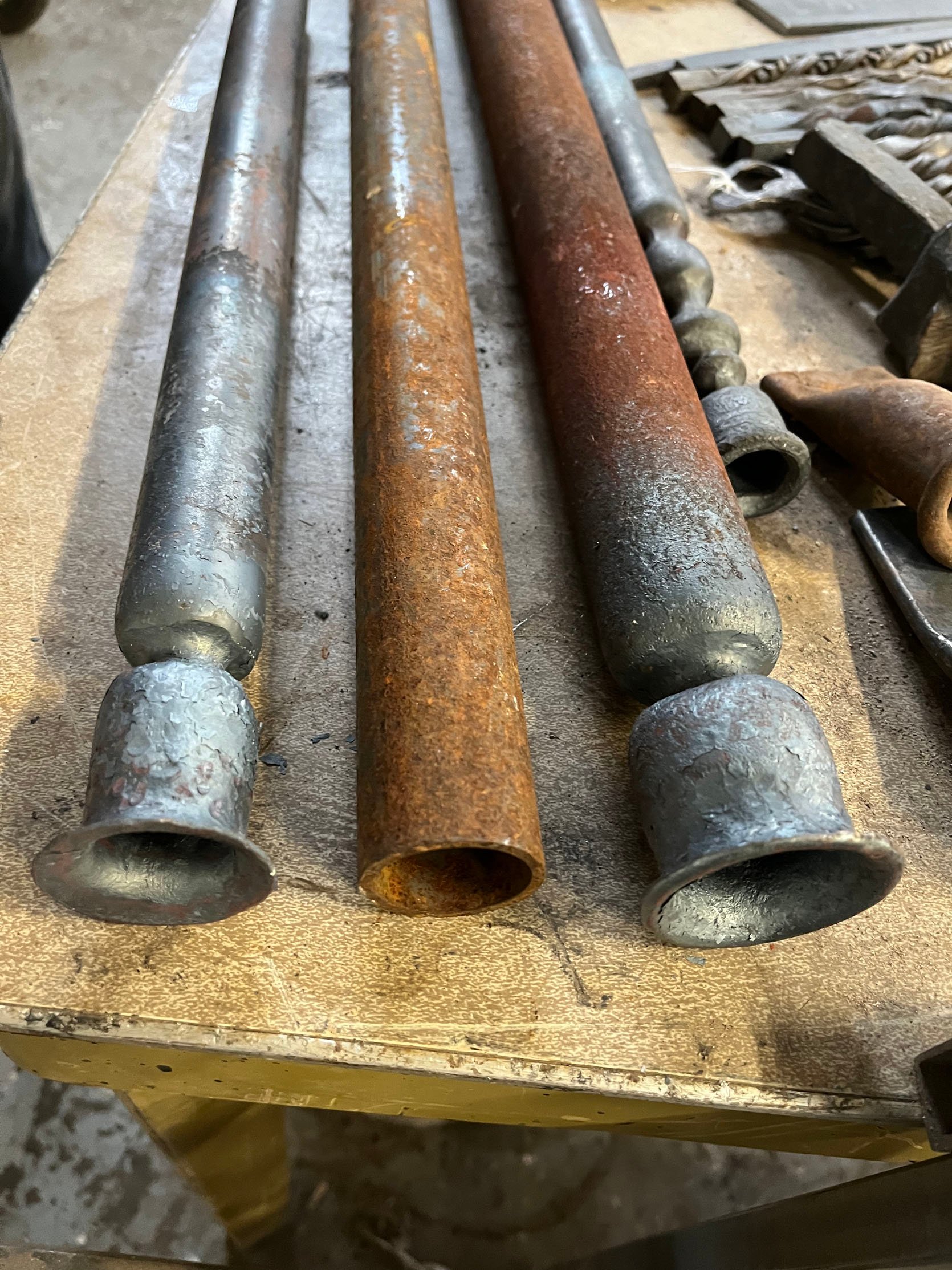
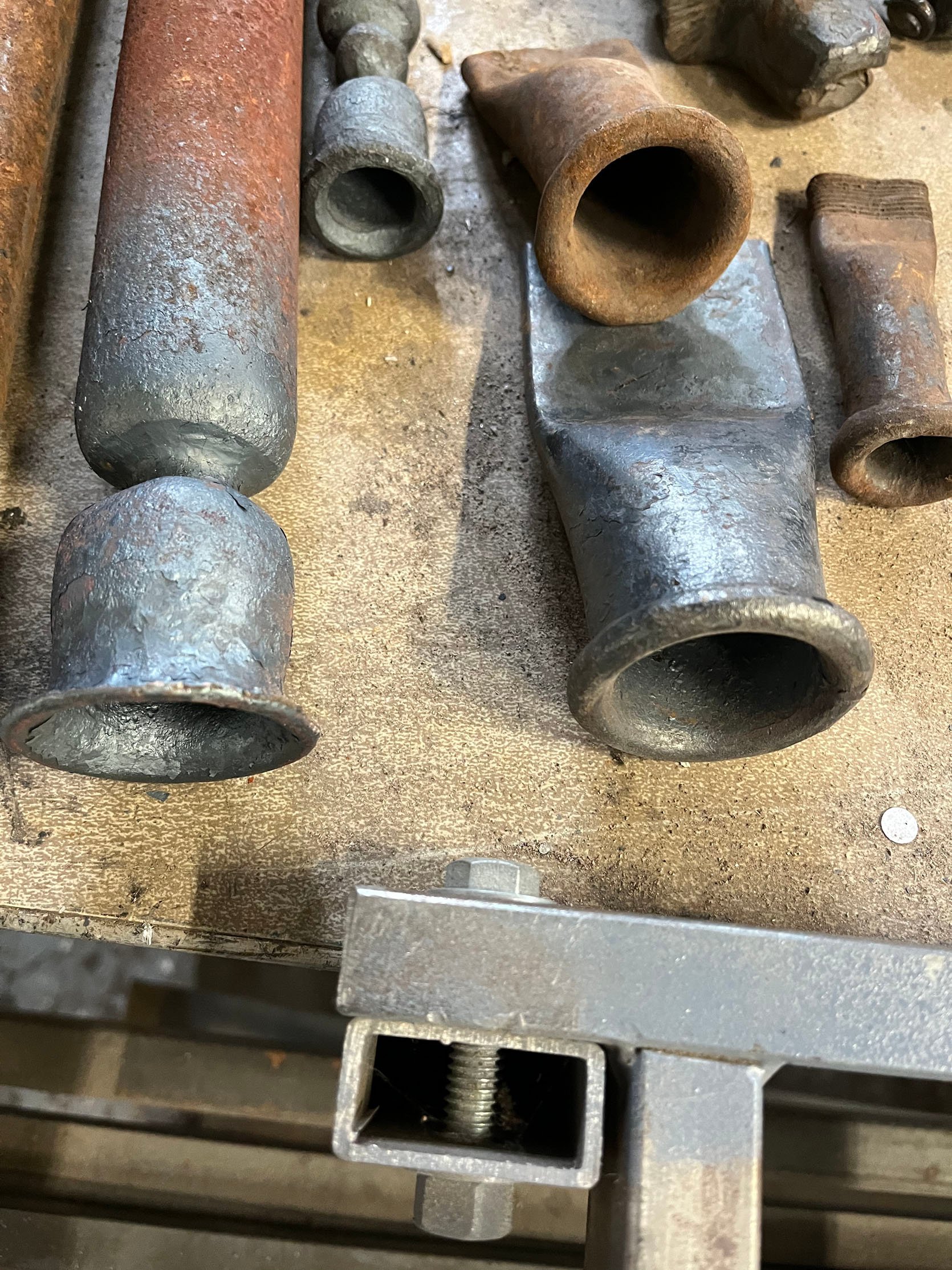
These were different leg samples we looked at with Billy. We considered the diameter of the legs – too thick felt weird and clunky, and too skinny didn’t feel substantial enough. We also debated whether we wanted the base of the feet more bell-shaped and whether the bell shape should be sharper or more rounded/curled up. Then we talked details, what shape we wanted the balls, more organic or more uniform, how many balls to put on each leg and the cross bars. Lots of ball talk.
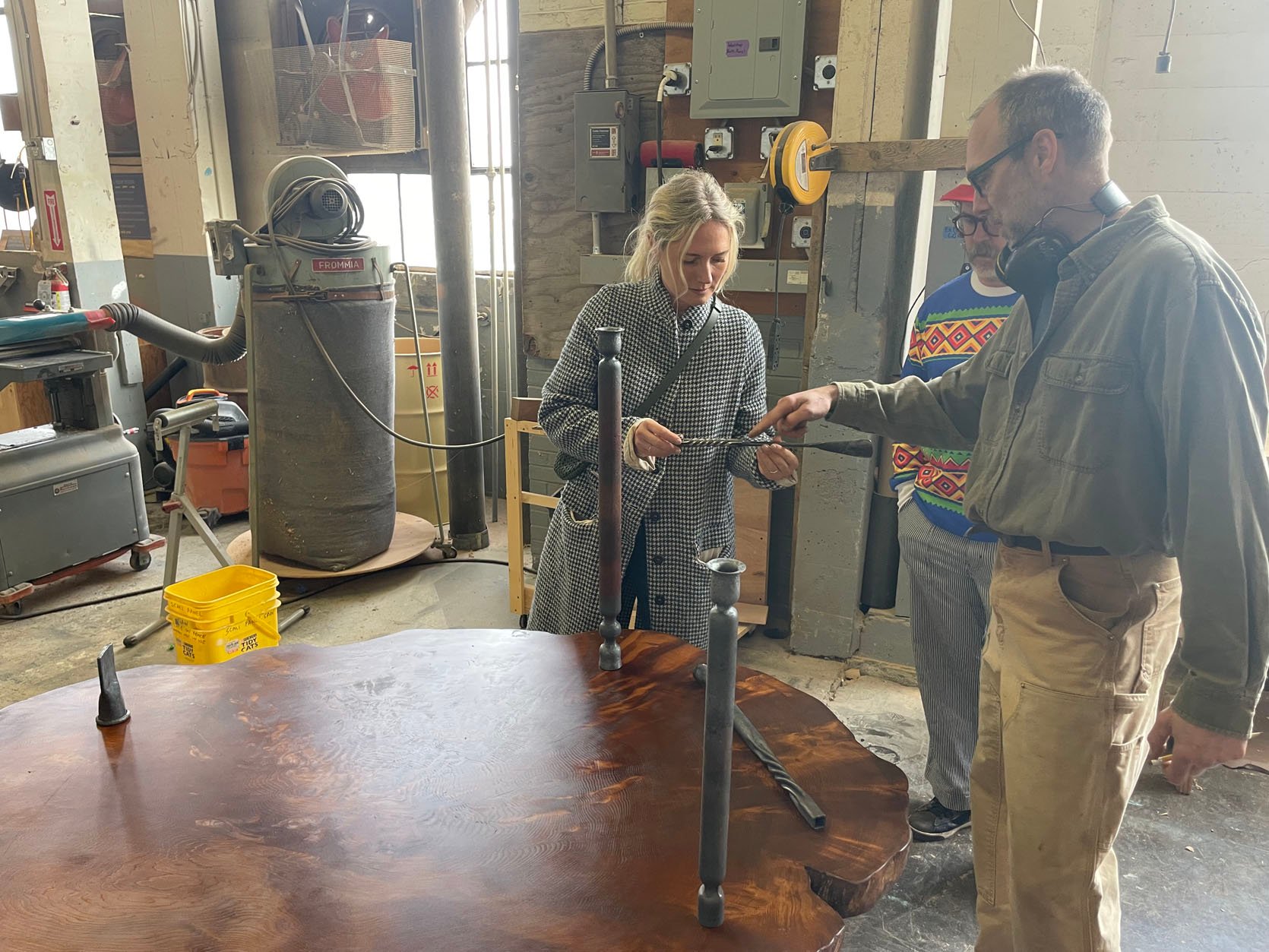
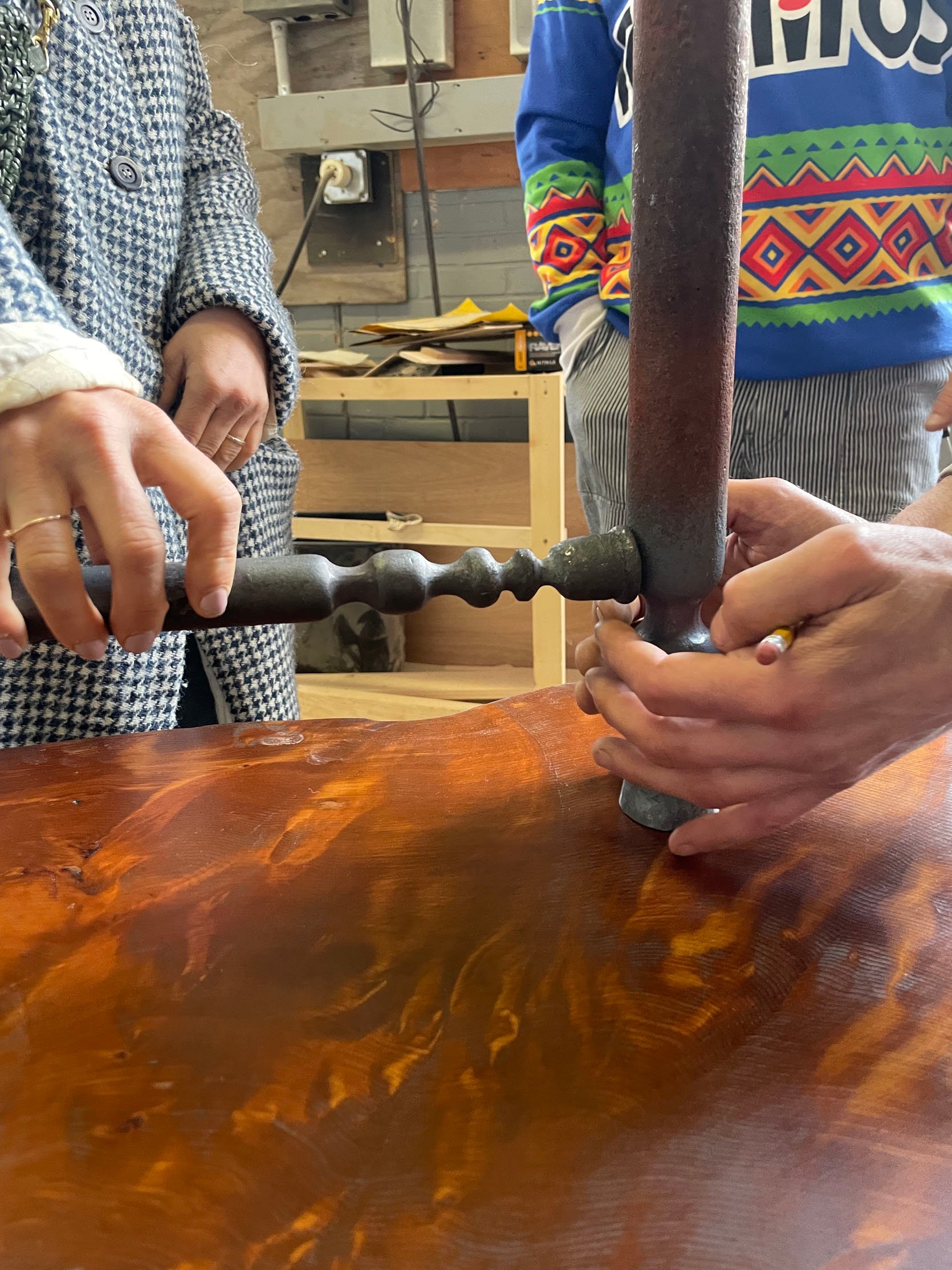
Then it was time to look at crossbars (or “stretchers,” as Purl called them). We discussed height and where the balls would land on the legs. We talked about actually crossing the bars but thought that would feel too busy and you wouldn’t see the craftmanship enough. We talked ball pattern (Do we go all the way across? Only have a few? Do the number of balls on the long crossbars match the ones on the shorter bars? Should the pattern be uniform throughout?). We also talked about how they should connect, discussed attaching with rivets but decided welding was better – it gave a more streamlined look and was less expensive/less work.
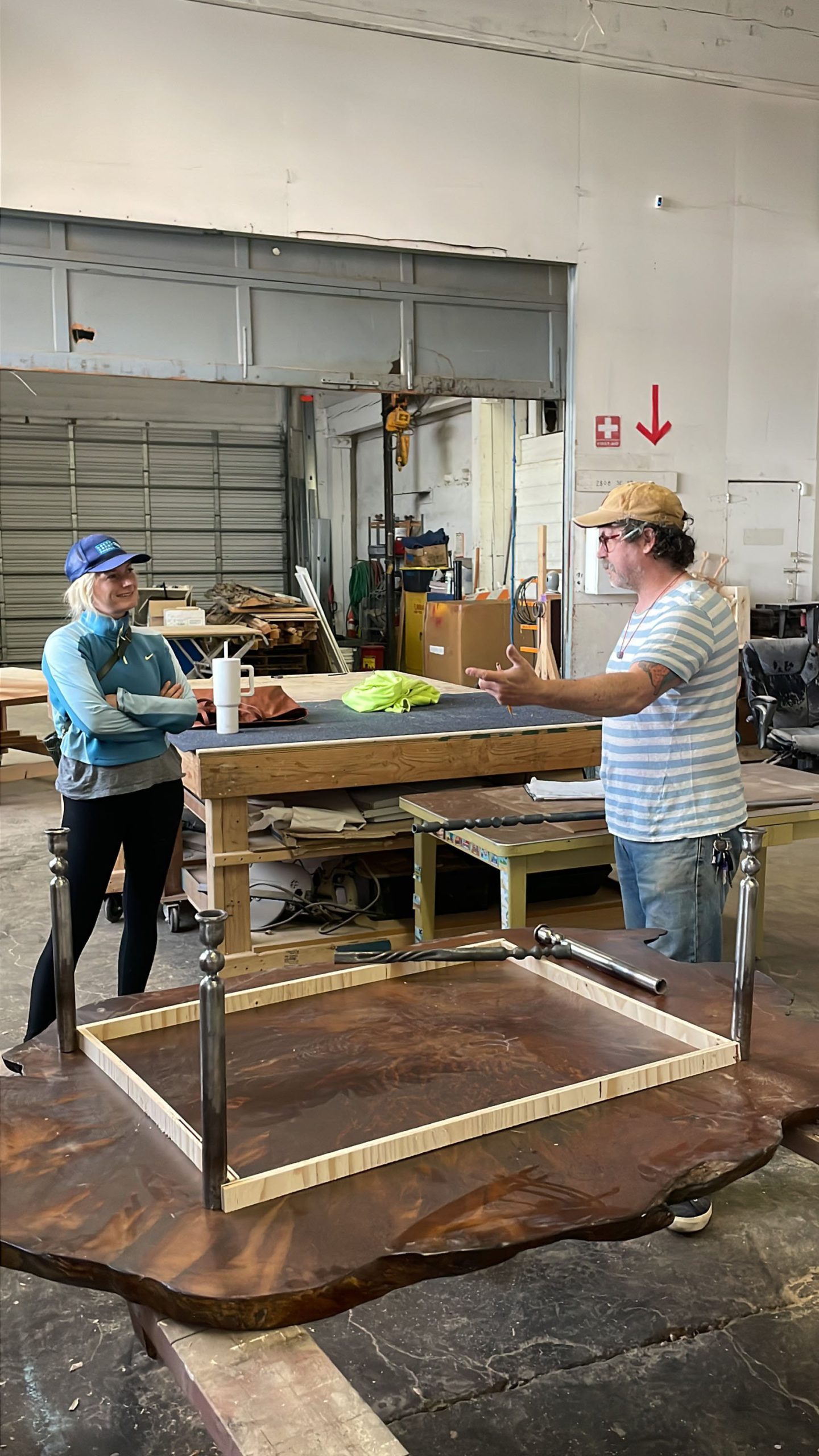
Then we came back for a third visit to approve the legs and figure out the spacing and placement of the legs/bars. The wood here represents the crossbar lengths. Nearing the final product here (and we were so excited), next up was one last stain, then sealing the wood, forging the legs and crossbars, sealing those, attaching the legs, then delivery. The timing was a little tricky because the sealant could take up to 12hrs to cure but these two worked so hard to meet our deadline.
Price/Hourly Breakdown:
So I don’t feel comfortable putting their hourly charge on the internet (that is up to them and could change at any point), but I thought it would be helpful to understand how much work goes into this kind of craftmanship (especially for a prototype, if they get hired to do more of these they said it would be faster as they’ve troubleshot a lot).
- The slab itself was $600 (which was a very good price, FYI, so if you are working with a dealer expect higher, but if it’s more of a found/reclaimed/vintage piece like this you can get some deals like we did)
- Billy the Blacksmith put in 20 hours of work
- The pipe materials cost $145
- Purl put in 15 hours in staining, sealing, and art directing
- Extra fees totaled $200
The total I paid was $3,650. This felt slightly higher than I had in my mind at the beginning, but honestly, we as consumers just tend to think things are easier and cheaper to make than they are, so I totally respected the amount of time and materials spent and feel honestly very grateful and proud of myself that I’m at a point in my career and life to support craftsmanship like this.
Wanna See My Forever Coffee Table??
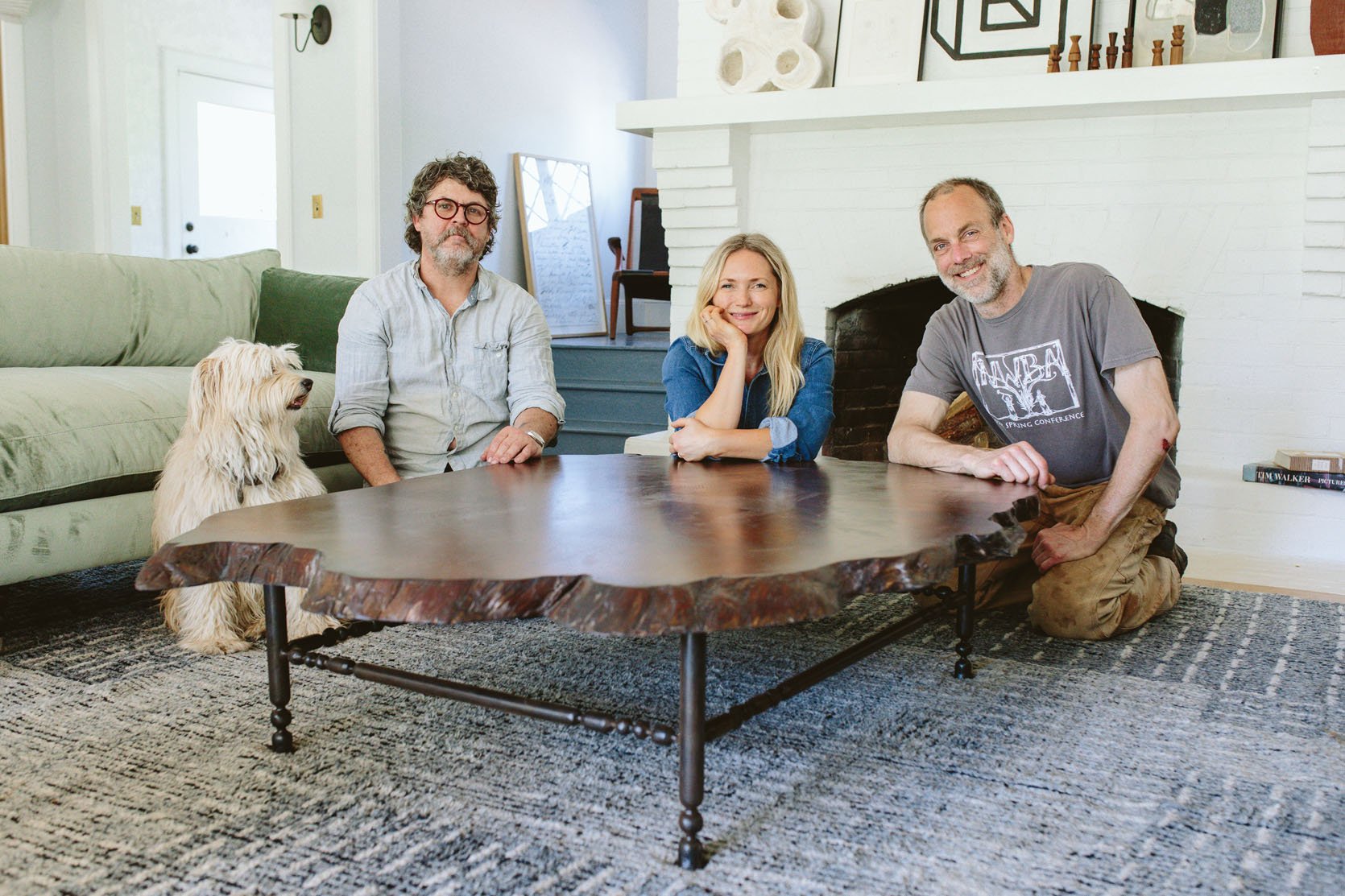
There she is!!! Is she revolutionary? No! And it’s perfect and exactly what I wanted. It’s a stunning piece that everyone comments on the second they come in. It’s the perfect height and scale for the room (we thought we could have gone bigger at first, but it’s actually ideal). The deep dark finish of the top is exactly what I pictured, and the hand-forged legs are neither too simple nor too busy.
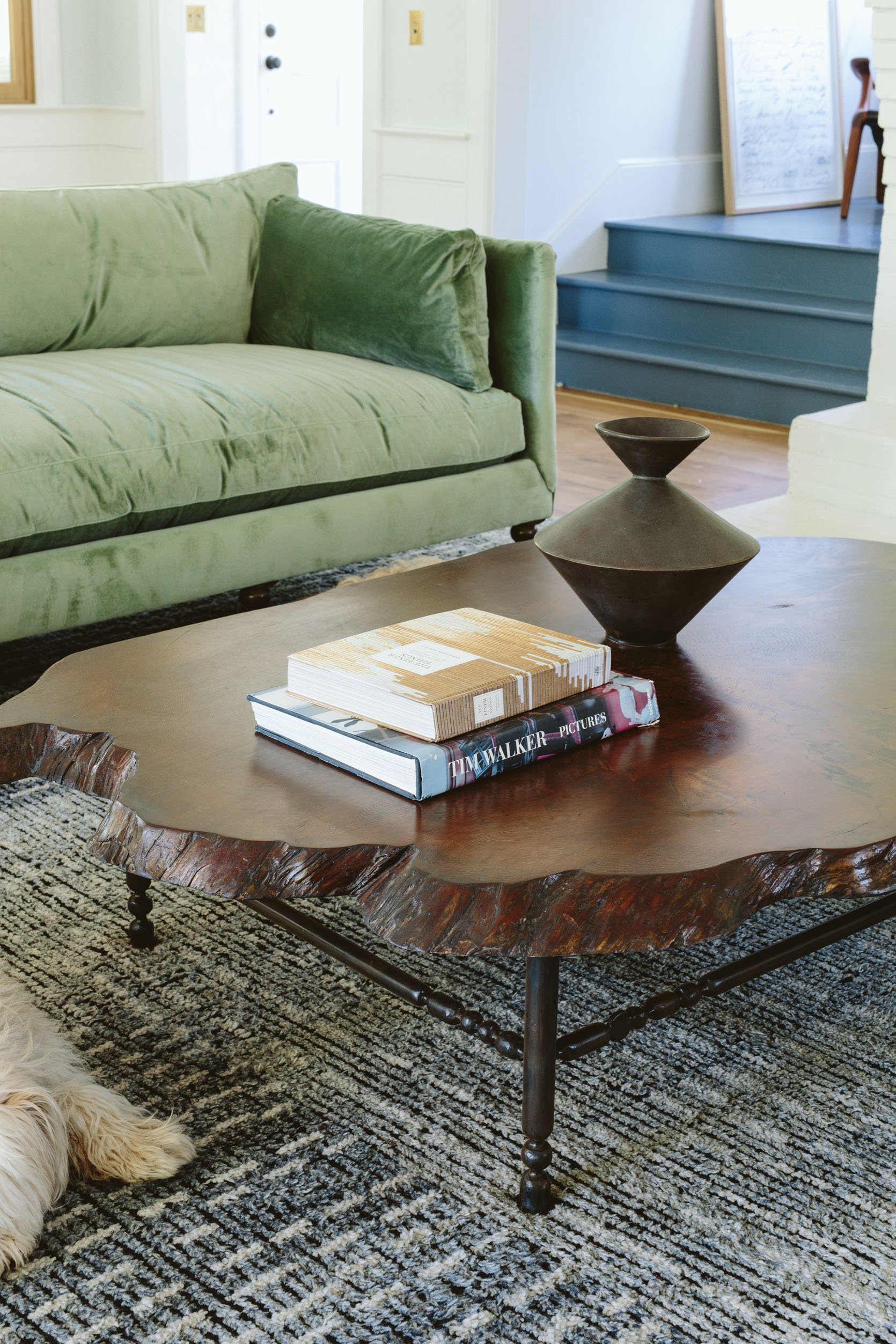
The edges just get me. They are so beautiful, sculptural, and truly mother nature’s work.
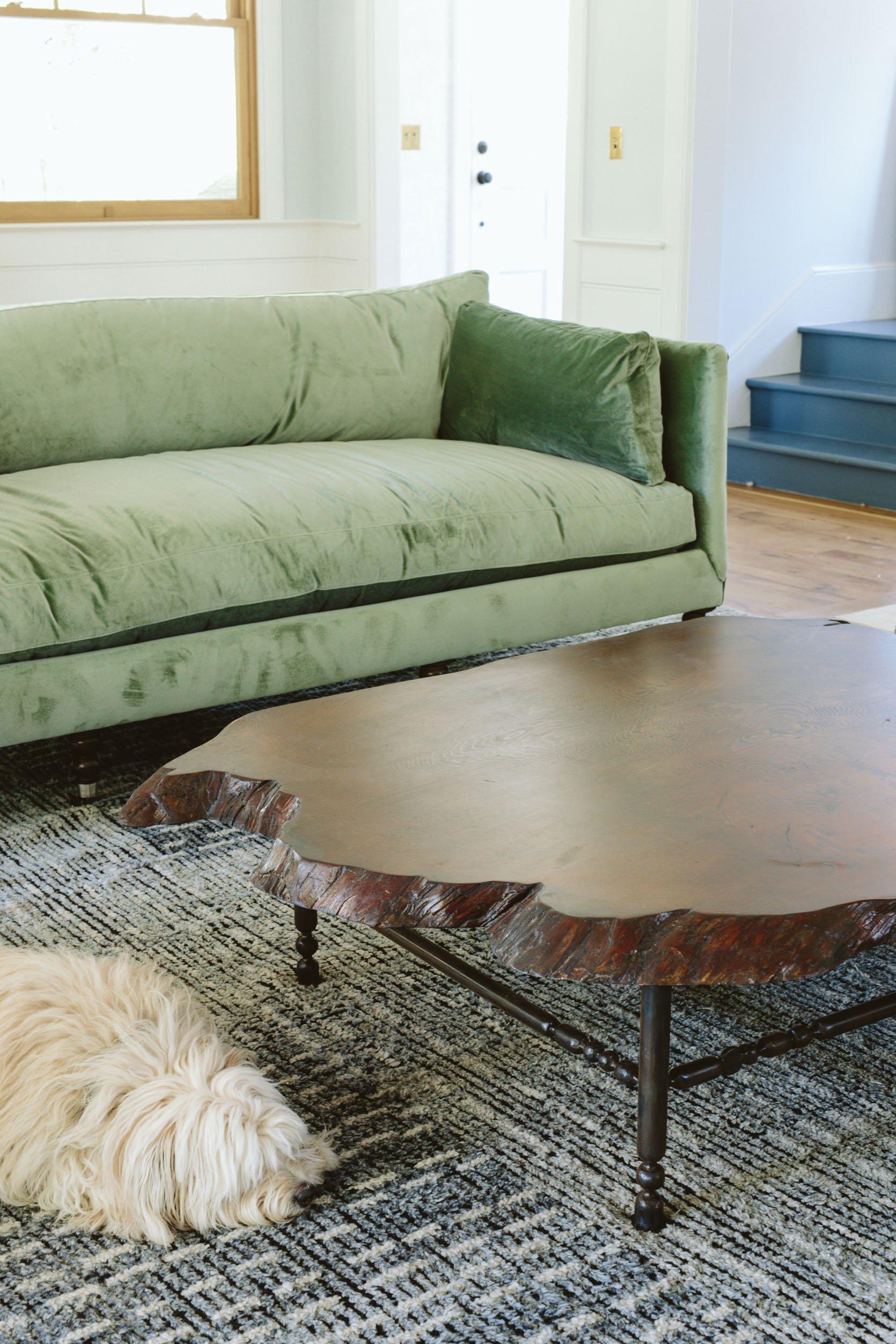
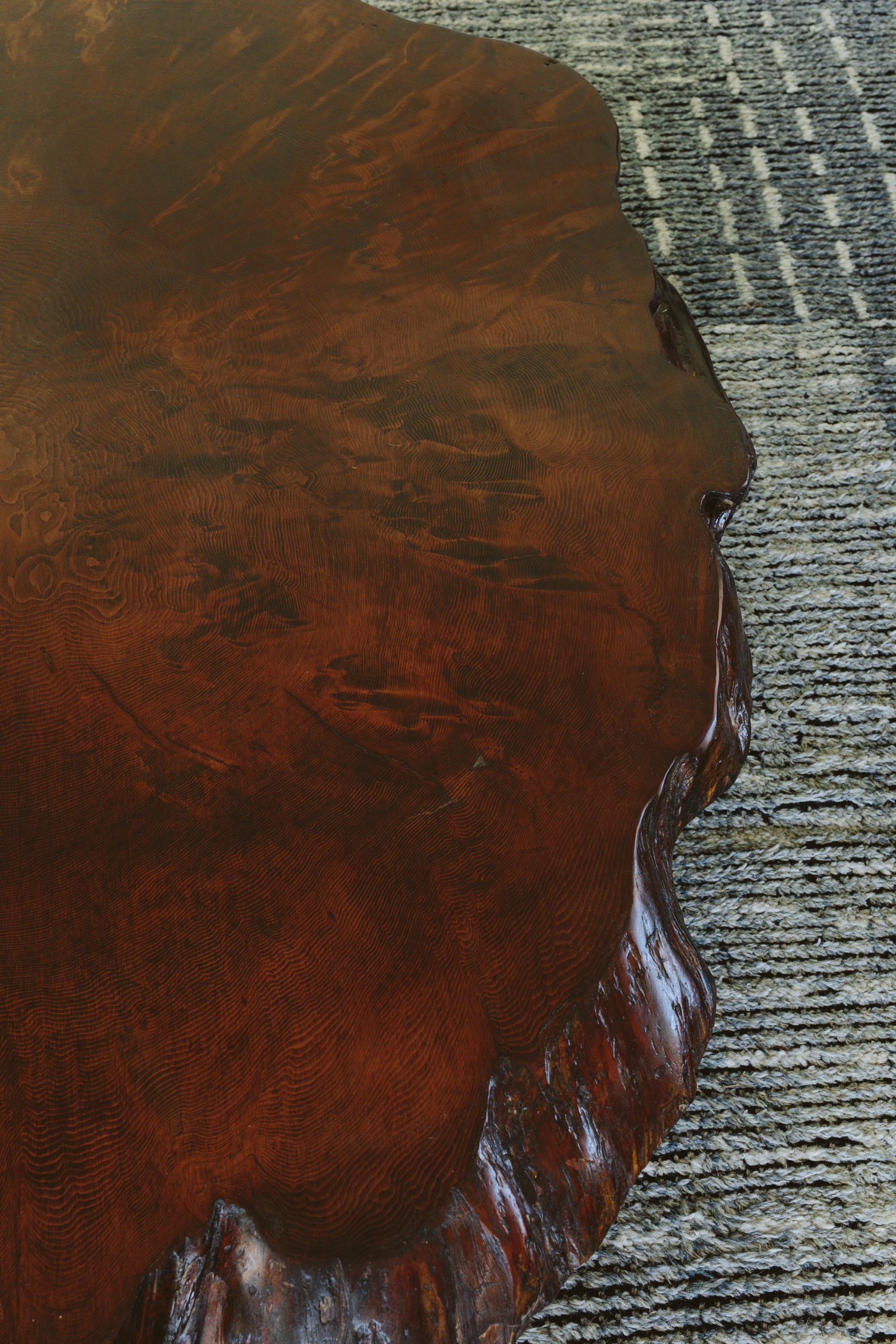
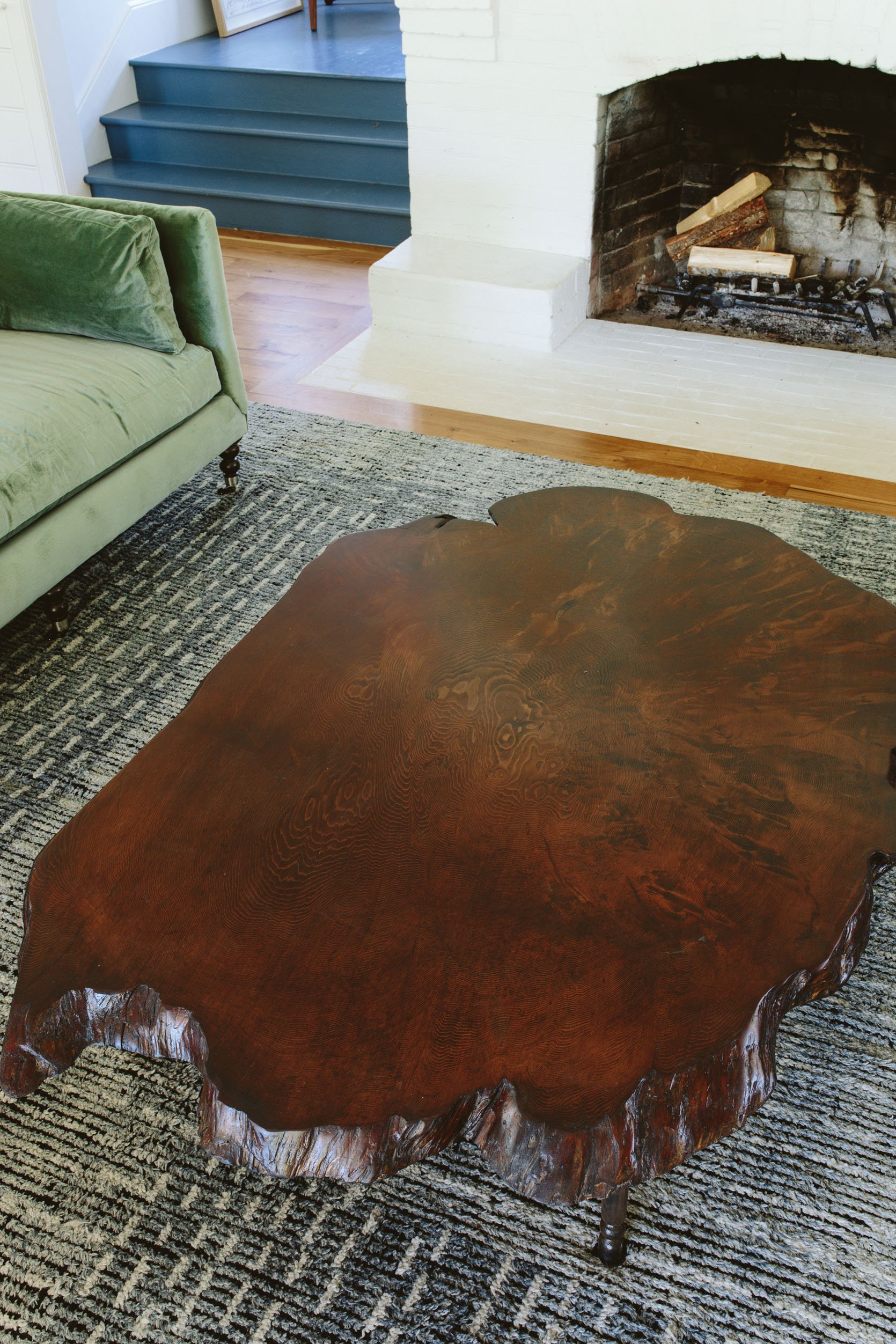
I love how it’s not a more contemporary white oak color, and instead creates this really rich depth in the room. It also hearkens to the ’60s and ’70s more with this finish (we left the shine on the edges) which I love so very very much. It’s not your grandma’s live edge table, but also it could be – it just feels super timeless and era-less.
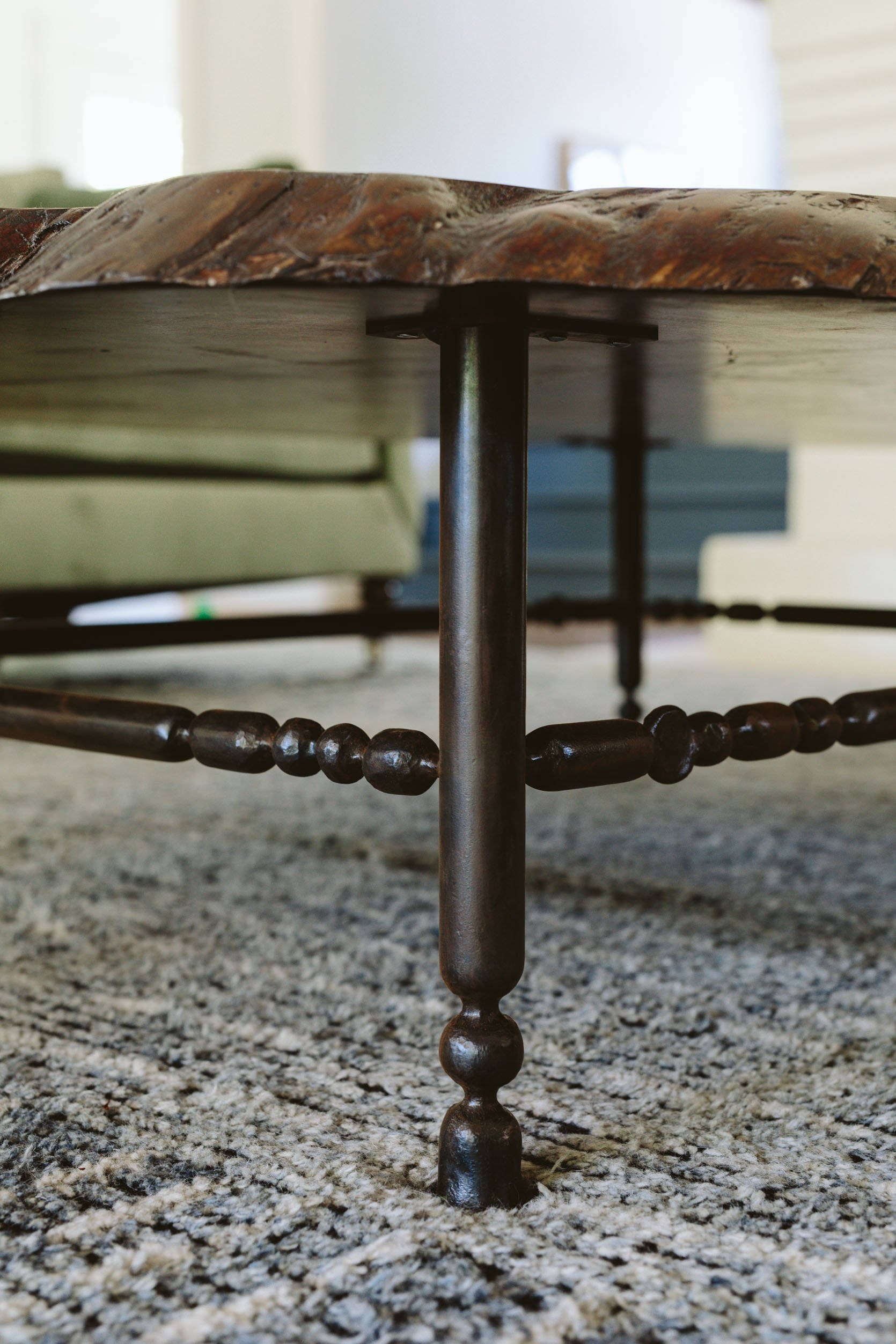
I love how Purl and Billy went “random” with the legs. Purl had a whole pattern planned, where he created different shapes and named them, then they repeated those shapes on all four crossbars.
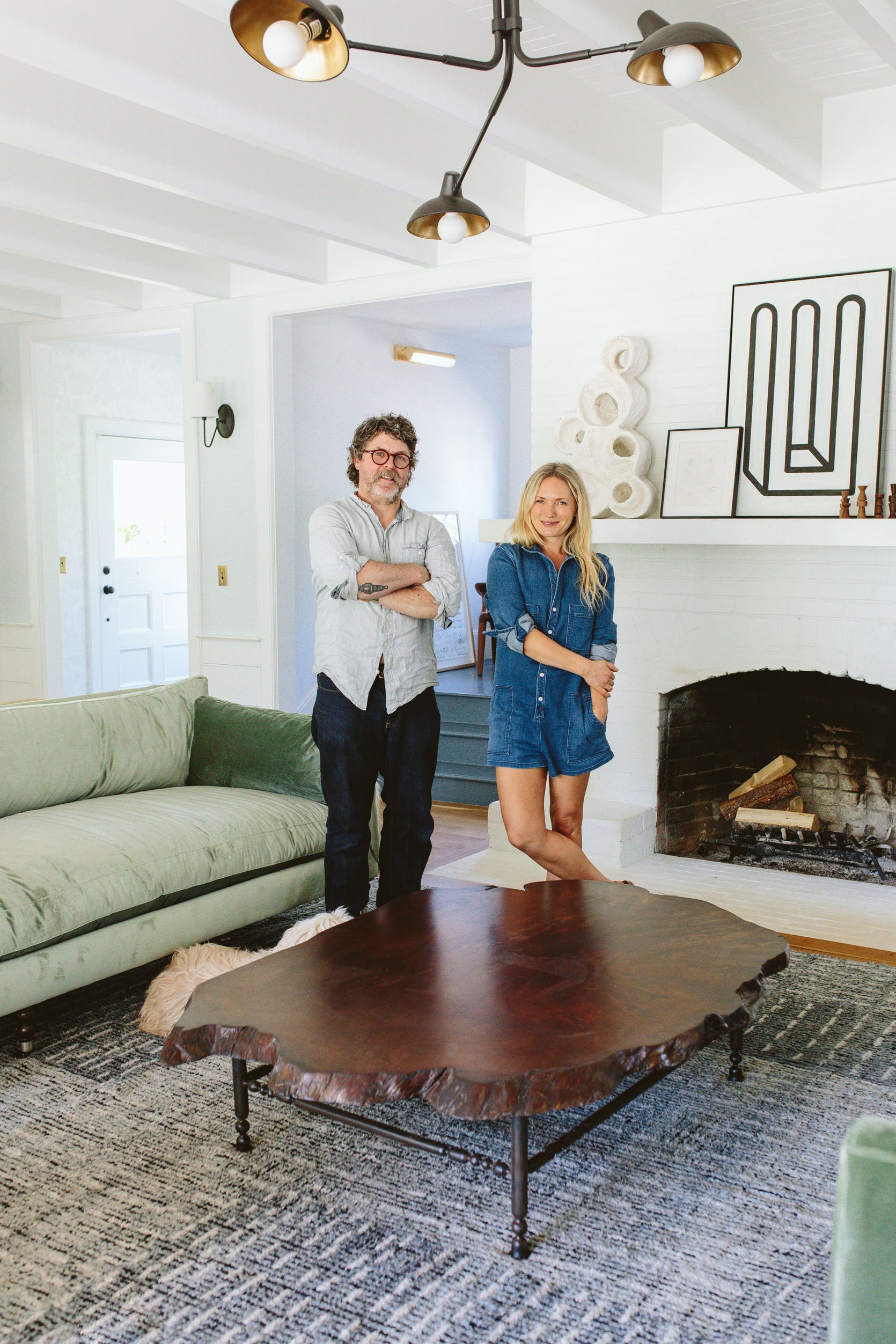
This is Purl, to the left. You all should follow him. He spent 18 years on a commune where he learned and practiced every art form and medium known to man, and his knowledge of art history is so impressive. I personally would love to see him on the next season of “Making It” (that show is incredible FYI and one that our kids love just as much as us). I’m glad that I was able to hire him before he blows up as I feel confident that he will. 🙂
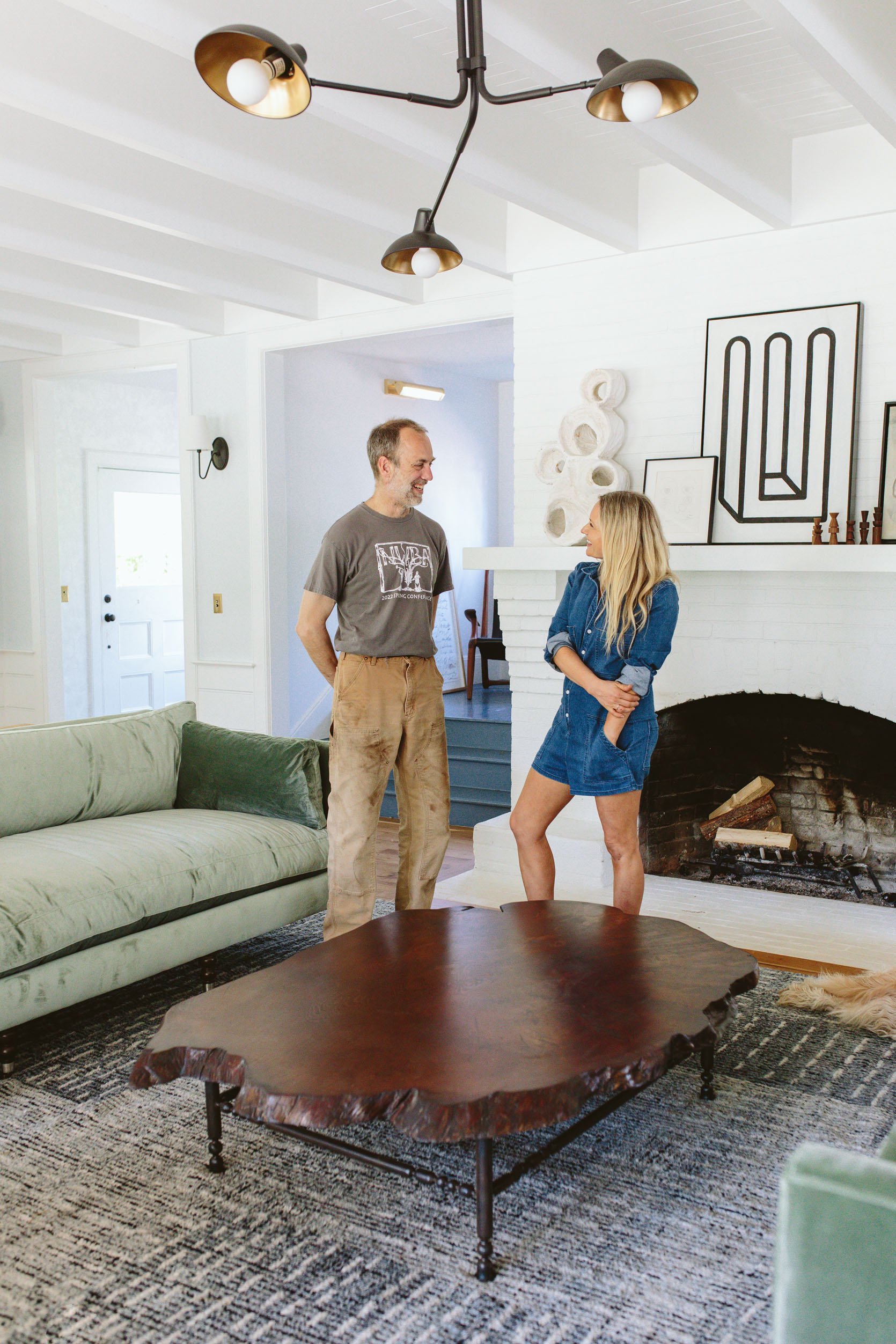
This is Billy who like most artists/makers isn’t terribly active on social, but he does have an account if you want to hire him. Both of them work out of Past Lives Makerspace with many other artists I’m excited to explore in the next few years.
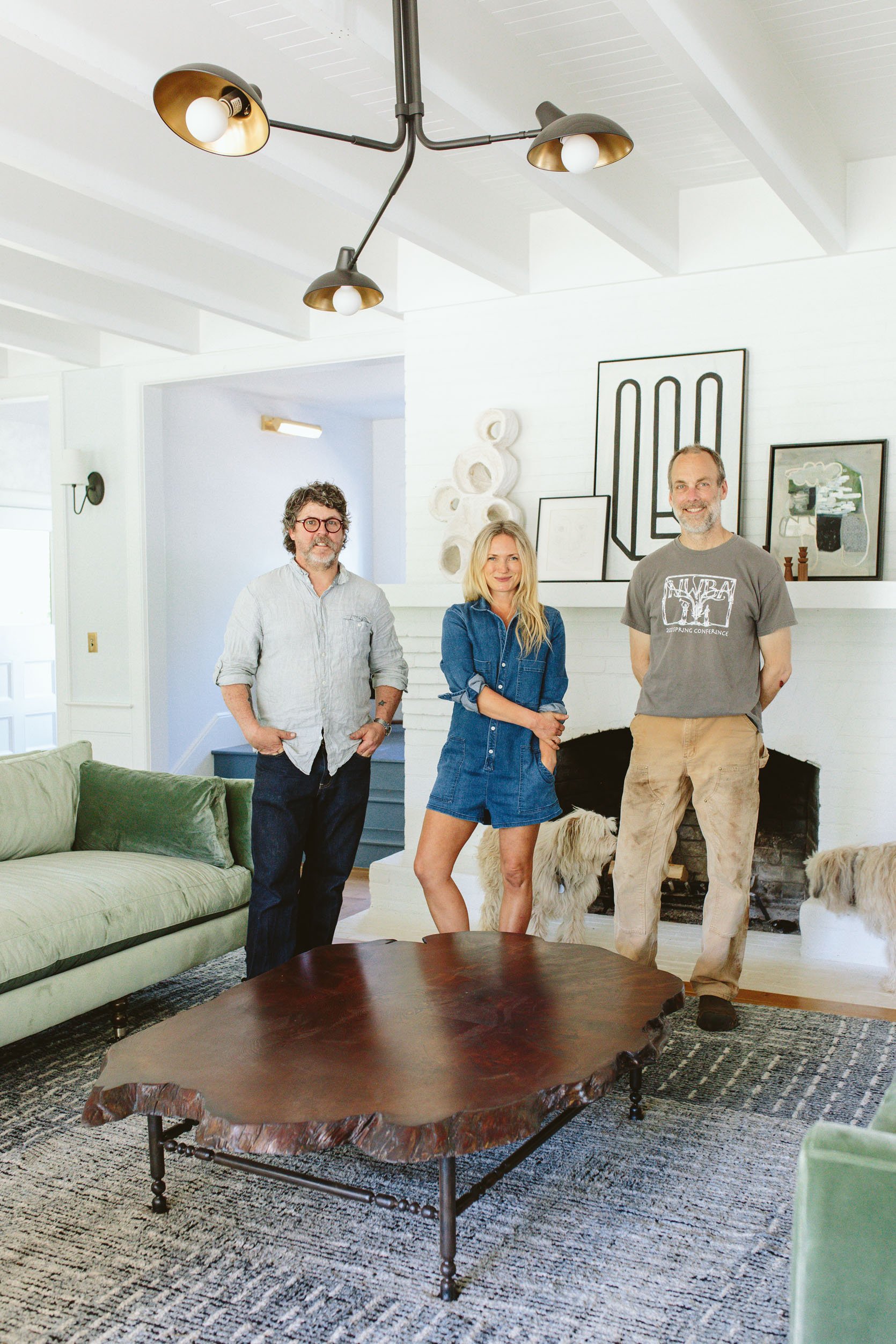
A huge thanks to Purl (left) and Billy (right) for this piece of craftsmanship that I get to call my coffee table. We are SO HAPPY WITH IT. Consider the “Henderson family coffee table heirloom” box checked forever (well, unless our next living room is tiny 🙂 but it will stay in the family forever). It makes me extremely happy and proud that this blog (and all of you) can promote and grow someone else’s career and livelihood. While doing this is not in everyone’s budget (and I’m so glad that there are affordable versions of this one on the market), if you have the budget to support local makers/artists in your area and do something like this, I think it’s a wonderful way to use your design dough and honestly makes me feel better about my other inevitable consumption:) I personally feel that pieces that tell a story (including heirlooms, travel souvenirs, and vintage pieces) are what really create a home. xx
*Living Room Photos by Kaitlin Green
THIS POST WAS ORIGINALLY PUBLISHED HERE.


